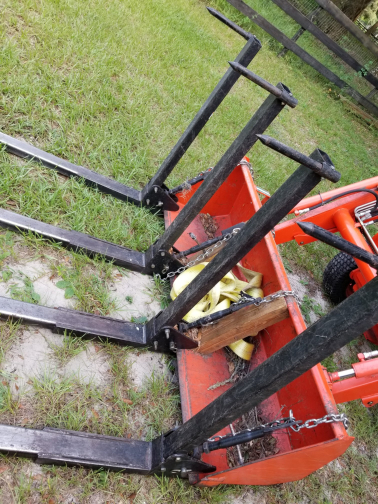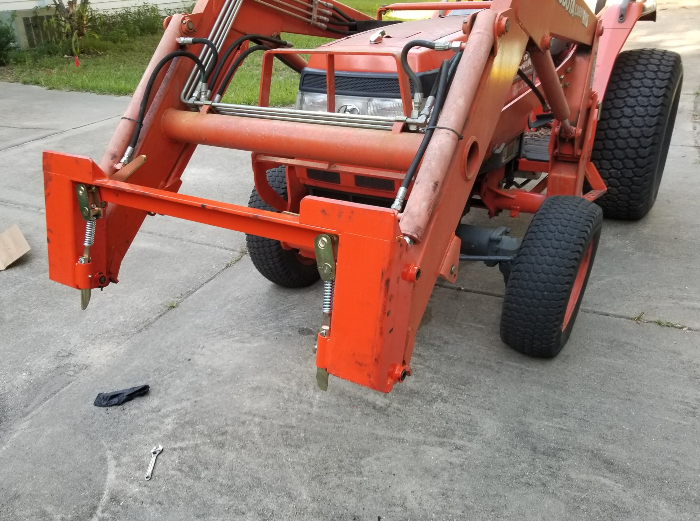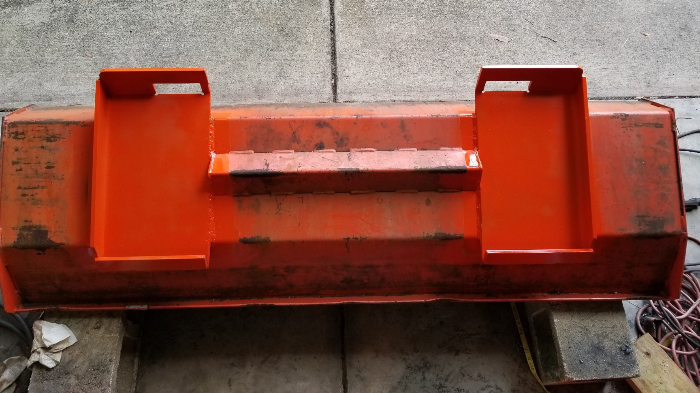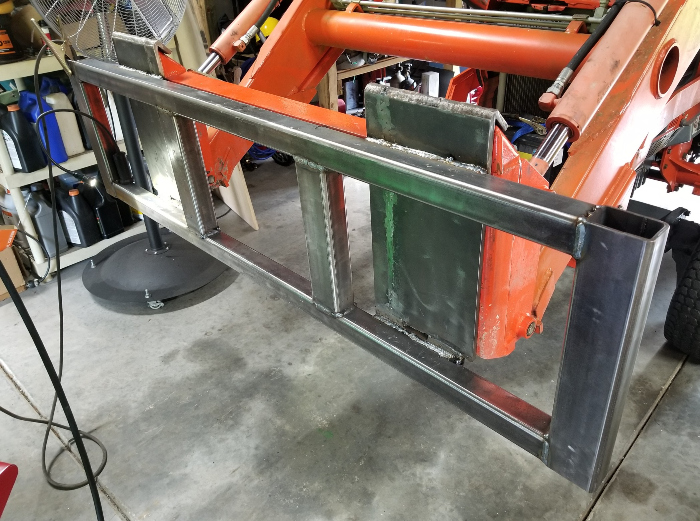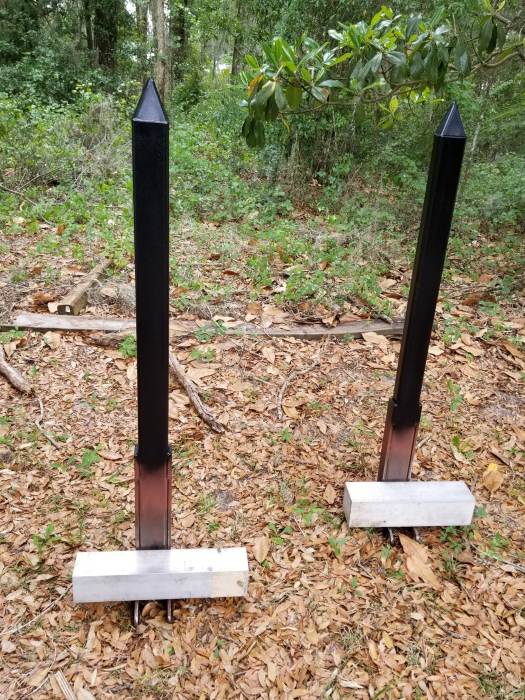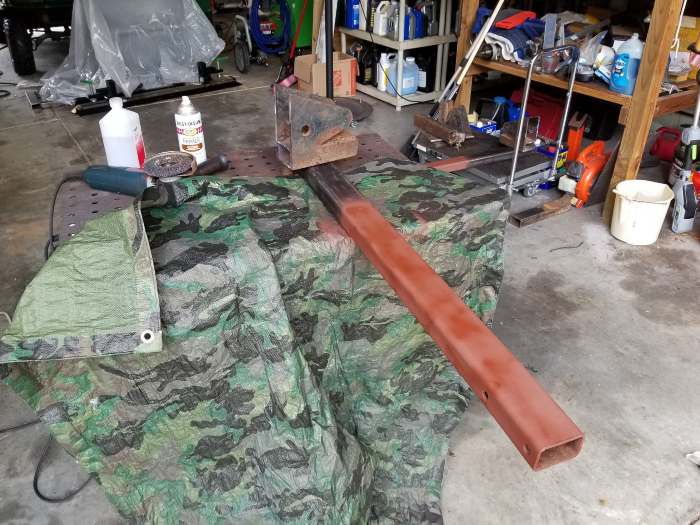Humanity Made it to 2022 Before I Invented the Tractor Debris Fork
April 22nd, 2023More Proof Engineers are Useless
I finally got back to work on my tractor fork attachment.
When I bought my tractor, it had 4 forks, or, more accurately, tines, on it. They were chained on with turnbuckles, and the chains went around the bucket. To prevent the bucket from deforming under the pressure of the chains, the previous owner shoved poorly-measured lengths of four-by-four into the bucket.
The tines worked extremely well, but they moved around all the time. It was not possible to tighten them enough to prevent this. Also, they were way out in front of the tractor, so the leverage was bad. They had to be mounted on the front lip of the bucket, so the distance back to the pins that attached them to the front end loader was pretty long.
On top of all this, in order to lift the fork, as I have decided to call the tines, I had to lift the bucket, which served no purpose in and of itself. The fork probably weighed 300 pounds, and that doesn’t include the bucket’s weight, which was probably maybe could be 150 pounds.
Let me check the weight of similar buckets.
The web says a bucket sold by Everything attachments runs 271 pounds, so I am off by a lot.
So before I could lift anything with “the fork,” I had to lift over 500 pounds of useless weight.
To make things even worse, the old bucket was held on by 4 hard-to-remove pins, and I could not use any other attachments without a ton of work. In practical terms, I couldn’t use the bucket because the fork was hard to remove, and I couldn’t use anything else because the bucket was hard to remove.
I got myself a thing that allows me to remove the bucket in about 90 seconds, and because covid, I was not able to get a bucket that worked with it. Instead, I did a lot of work and changed my existing bucket so it fit. This left me with a bucket I could use, but I was not able to use the fork, and the fork was what I needed for at least 95% of the jobs I did.
The answer: buy a new fork attachment.
No. Don’t be stupid. There is no such thing.
You can get a set of forklift forks for a tractor. They cost a lot, and you only get two tines unless you pay extra. The tines are short and poorly suited to moving logs and brush, and they move around if you use them the way I need to use them. Stupid.
You can’t move brush with two tines. You need at least 4 unless you want things to fall between the tines. I have a cheap set of two Chinese tines that clamp on my bucket, and while they are certainly helpful, they will never move brush.
You can get a thing called a grapple. This is like a 60″-wide set of salad tongs connected to hydraulics. People love them. I don’t. They are also stupid.
You can pick up logs with a grapple. So what? I can do that with the fork, and I can pick up more logs, because a fork is bigger. And I could handle loads that were much bigger than anything that would fit in a grapple. You can pick up brush in a grapple. So what? I was able to move huge piles of brush with the fork. Again, much bigger than anything that would fit in a grapple.
Also, to use a grapple, you have to add some stuff to your hydraulic system. To get something that isn’t as good as a fork without added hydraulics. And a good grapple weighs 400 pounds.
Grapples are dumb. I’m convinced of it. They cost a great deal of money, they require tractor modification, and they don’t work very well compared to a set of tines.
I think men buy grapples because they’re cooler than forks and because they don’t really know what they’re doing. When you have a grapple on your compact tractor, you can pretend you’re Truckasaurus, but you can’t really get much done. It’s amazing to me that no one offers a factory fork attachment like the one I’m building.
My answer: cut up my existing tines and attach them to a shopmade steel frame that works with a quick-attach adaptor like the one I now have. This will reduce the weight of the whole mess. It will move everything closer to the tractor, improving the leverage. The new attachment will be rigid, so the tines will not move around. I won’t have to change my hydraulics. It should weigh a hundred pounds less than a grapple.
Down side: it has been almost a year since I started working on it, and I am still not done because covid pretty much destroyed whatever ambition I had when I first realized I needed to do something. There is a lot of stuff on my property that needs to be moved.
So far, I have built the frame, cut up the forks, and primed and painted certain parts of the tines that will be hard to paint once the project is welded together. Over the last couple of days, I cut one tine up and did a lot of rust removal, priming, and painting.
I really do not understand how people who make tractor attachments can be so incompetent. You can go to Youtube and find shopmade fork things that are a lot like the one I’m building, so it’s not like I invented the transistor. If you use a grapple, and you’ve seen people use a fork, you know perfectly well that the grapple is inferior in every way. So why can’t I buy a fork ready to go?
I have 4 tines. They were originally maybe 6 feet long. Something like 4 feet extended out in front of the bucket, and the rest went under the bucket. When something heavy rested on a tine, the rear of the tine pressed up on the bucket. The idea was to add strength and provide a tine that would not bend where it met the bucket.
This was a stupid design. It added weight and complexity, and it required tight chains to pull the tines back against the bucket lip. This deformed the upper part of the bucket because the chains pulled down on it in spite of the pitiable four-by-four supports, which fell out all the time. This is what happens when a person who only knows how to run a wood band saw tries to do a job that requires steel and a metalworker. When all you know is carpentry, every job looks like a pine deck.
I can weld short pieces of heavy tubing in the corners of the tines to serve as gussets. If that won’t prevent the tubes from bending downward, nothing will. I will also put horizontal pieces of tubing in the corners to keep the tines from opening or closing.
I guess I shouldn’t be harsh. I don’t think the quick-attach adaptor had been invented when my tractor was new, so the old arrangement was probably the best the attachment companies could do. Still, why wasn’t the adaptor invented in, say, 1935 or soon after whatever year it was when hydraulic front-end loaders arrived on the scene?
My fork had 4 upright steel tubes to prevent things from falling back toward the tractor when the bucket was raised. This week, I de-rusted and primed two of them. I also put one on the hydraulic press because it was bent, and I got it nearly straight, which amazed me. I’ll be fixing the other two uprights shortly. It’s easy. If I get tired of the slightly-crooked one, I can make a new one in half an hour, or I can turn it upside-down, do a little welding, and have an upright that’s only crooked for the top 6 inches. That’s where the bend is.
Each upright member had a stupid spike at the top, facing forward at face level. When I bought the tractor, the two outboard spikes had tennis balls on them. I wondered why until the first time I walked into a spike. Today and yesterday, I used the belt grinder and the lathe to round the ends of the spikes. Why they had to be sharp in the first place is a mystery to me. Why no one ever thought to round them off later is also a puzzle.
My plan is to put the uprights back on the fork and then put some goat wire across all four of them. This is fencing wire laid out in a grid. The wire will weigh about 7 pounds and prevent things from coming back at me or the tractor between the uprights. Why no one else thought of this…well, I think we’ve already discussed the competence of the people who make tractor stuff.
I’m using rusty-metal primer on a lot of the attachment, and I’m finishing it with Herculiner. This is the toughest finish I can get, and it’s easily touched up with spray cans from Tractor Supply.
I assume this design will work. If not, I’ll get a grapple, and I’ll be out around $300. But why wouldn’t it work? The old system was held on with two brackets of 3/16″ steel channel about 10″ long. If lifting hundreds of pounds of wood using 4 pins on two little brackets with 4 little welds didn’t destroy everything, my relatively robust system should be a lot better.
When all this is done, I’ll have a bucket and fork I can swap in a minute or two, so I’ll actually use both. How nice that will be.
It seems like I excoriate engineers all the time for their stupid mistakes, but I think I’m completely justified. I have a physics degree and a small amount of common sense, but physics training in no way makes you an engineer. It enables you to pick engineering up fast, but it’s not the same thing. Physicists don’t know how to do anything. A physicist might be able to tell you how LED’s work at the subatomic level, but it takes an engineer to design an LED TV. If I can dramatically improve the work of engineers over and over, and I can, then something is wrong.
They always blame marketing and accounting. “We wanted to make it right, but the marketing and accounting people wouldn’t let us.” Boo hoo. I’m sure that explains a lot of problems, but it doesn’t explain many others. Why didn’t we have plastic trash bags until the 1960’s? Obvious? Why did American cars require two keys long after the Japanese realized only one was needed? Why have boat designers put so many bilge pump wiring blocks 6″ above the normal level of salty, conductive bilge water?
Why did it take so long for engineers to put seat belts in cars? They were invented in the 1800’s. The first American cars with seat belts appeared in 1949.
Engineers gave my car thin, easily-clogged moonroof drain tubes, and then they fixed it so any overflow was captured in headliner cavities containing overly-complex and expensive motors. An engineer gave my lawn tractor a front grill cover that falls off easily and lands directly in front of the tractor’s front wheels. Guess what happens then. Owners all over the web are looking for new grills.
My opinion of engineers is like my opinion of cooking school graduates. Think of all the terrible food you’ve had at expensive restaurants. Most of it was cooked by chefs with degrees. There is no conceivable excuse for going to school for several years and making bad food. Cooking is just not hard. Somehow, they blow it anyway. Very, very often.
Now I feel like writing about my awful green toilets again. I just spent $700 ordering a better one, made in Japan.
Unless I have missed something, my tractor fork will be fantastic. If so, I’ll probably come back and criticize engineers some more. They have it coming.
